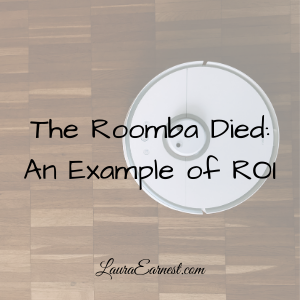
The Roomba Died: An Example of ROI
Some time ago I came home from work, to find our Roomba had committed suicide. It had flung itself down the stairs and was laying, face down on the stair landing, one wheel laying a few feet away. I’m not sure what caused the machine to go to such drastic measures…I’m pretty sure that my house is not dirty enough to cause a vacuum cleaner to decide to off itself. And the Roomba had made two previous attempts, so I suppose I should not have been surprised.
So the question, after scavenging the machine for parts (no, not even a decent burial here), the question became: do I replace it? It came down to ROI.
Replacing vs. Doing Without
This can happen to a lot of things around our houses, especially in the current day of planned obsolescence. Sometimes the things that have been used and died are really not all that useful. And sometimes they make our lives much easier.
I sat down and made a list of pros and cons to having a Roomba around.
Cons
- Roombas are expensive. At over $200 a pop, they are definitely something I need to think about before buying.
- Roombas break. In all the years I have used Roombas (15 years or so), this was number 8 (including under-warranty replacements).
- Roombas can require more maintenance than regular vacuums. I have found that the only way to get around the breakage was to disassemble the vacuum regularly and clean it out. This is on top of cleaning the brushes weekly. The newer models that are designed for pet hair probably don’t have this issue.
- Roombas get caught. They don’t handle stuff left on the floor very well, and cotton swabs (a favorite cat toy) will jam them up good. So will yarn, earphones, charging cables, and lamp cords.
Pros
- I don’t have to vacuum. I’m not pushing the vacuum. Since vacuuming ranks right up there with childbirth and ironing in my list of non-favorite things to do, this is a big plus.
- Roombas run unattended. I can set the machine up, turn on the virtual walls to keep it corralled, and let it go.
- Roombas go under the furniture. Under beds, dressers, chairs, sofas. This saves me having to move furniture to dig out the furballs and dust bunnies, and keeps the rooms cleaner overall.
- Roombas handle multiple surfaces. My roombas handle carpeting, hardwood floors with rugs, and tile equally well.
All this told me is that the device is useful and convenient, but has drawbacks.
Analysis
Roombas work well, when they work. It’s hard for them to keep running. So is the ongoing quest for me to keep them going worth the benefit they provide? This is a question I ask myself every time I have to replace them.
So it boils down to cost-benefit analysis…return on investment (ROI). It would take me approximately 1.5 hours per week to vacuum the floors in the house. That does not include going under the furniture, which would take another 2 to 3 hours per month. So figure 9 hours of my time per month vacuuming. If the Roomba costs $200 and can last for one year (that’s the warranty), that means that the cost per month will be $16.66.
Is my time worth more than $1.85? Absolutely.
ROI
This technique can be applied to anything that we are considering replacing. It’s not just about the money, but also the ongoing effort required to keep the item maintained. It has to be balanced against the benefit that the item brings you.
Hopefully you can see how this analysis works out and apply it in your own situations.




